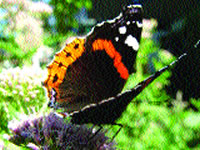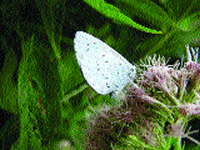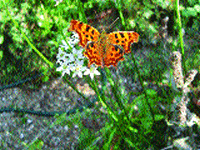Positive Health Online
Your Country

Herbal Beauties in Late Summer
listed in herbal medicine, originally published in issue 139 - September 2007
Late August is a beautiful time of year with sunny days and balmy evenings. After work, it is so refreshing to sit outside or take photographs so as to remember the herbal beauties of late summer. Many say that by this time most gardens are more or less spent, and look rather worn. Not so the Aromatherapy Fragrance Garden. Due to the core of the garden planting being herbal, it really does look pretty in a shabby-chic kind of way in late summer! It takes on a hazy appearance as the mature herbs, preparing to set seed, become almost feathery with countless minuscule flowers and seed heads. Some of these plants have, by now, grown over five feet high and make the garden appear to be made up of secret areas, especially if one is short in stature like me!
One of the outstanding features of herbs to be enjoyed and appreciated at this time of year is the pollinators that they attract. These can be a variety of bees, insects or butterflies and moths. 
Red Admiral and Eupatorium cannabinum
Common Blue Butterfly and
Eupatorium cannabinum plant
Comma Butterfly on Garlic chives
By day, the pale pink-to-white flowers of the Hemp-Agrimony, (Eupatorium cannabinum) are covered with these bees, butterflies or moths, drawn by a delicious scent which is sweet and delicate. Hemp-Agrimony is a tall plant with fluffy heads made up of hundreds of tiny, almost insignificant, trumpet-shaped flowers. The flowers have a long protruding style which is what gives the whole plant the furry look mentioned above. They must be a rich source of nectar if the numbers of pollinators visiting them is anything to go by. The leaves are lance-shaped and dark green.
Adjacent to this is the Eupatorium purpureum which is very similar, but has purple stems and creamy white, pink and pink-purple flowers. This plant carries several folk names, but in her book Herbs, Lesley Bremness tells how the name Sweet Joe Pie originated.
“This herb is named after a North American Indian called Joe Pie, who cured a grateful New Englander of typhus. The Indian used this plant to induce profuse sweating, which broke the fever.”
Both these beautiful herbs are very sturdy, and will stand up against some of the storms which can arise suddenly in late summer.
The apple mint, (Mentha suaveolens), is strongly scented with a sharp spearmint/apple aroma and also attracts a wide variety of insects, butterflies and moths. This herb is very hairy, with square stems, as is most of the Lamiaceae family. Its leaves are a bright greyish-green and more rounded to oblong than some of the other mints. The diminutive florets appear late in summer, clustered together on spiralling branched spikes. Colours can range from white to pink. The leaves can be used to make a delicious tea, and even just crushing a leaf between the fingers will release its refreshing aroma and enliven a tired mind. Apple mint is rhizomatous and, therefore, can be invasive if left unchecked. Some support the idea of planting it in a sunken container in the ground, but eventually the mat of roots migrate to just the outer edge of it, and the middle becomes unsightly with nothing growing there. To keep mine within the central border, I simply pull up outgrowing roots.
Another late flowering herb is the garlic chive, (Allium tuberosum). The leaves are flat and solid, rising from the bottom of the plant. They smell of garlic if crushed. The white, star-shaped flowers are appealing and surprisingly, smell sweet. They appear on umbels at the end of long stalks. These too are excellent pollinator attractants. The roots are rhizomatous, and I grow mine in a large pot as they do not gravitate towards the edge of it, (as in the case above), but stay where they are planted. Last year, this little plant attracted a Comma butterfly, (Polygonia c-album. Linnaeus 1758). This was unusual, as it, supposedly, does not come this far north in England. One needs to be observant to see this butterfly as its ragged wing edges can make it appear as a fallen leaf. The underside has a white mark in the shape of a comma. Considering that this beautiful creature had only two sightings up to 1920 after a crash in population, it makes one feel very privileged indeed to observe it. The population is now recovering splendidly.
There are many other plant wonders to observe in late summer, which are either late flowering or attractive seed heads. To name but a few in the Aromatherapy Fragrance Garden there are lavender, buddleia, phlox, passion flowers, and lilies. Some of these have spectacular colours; especially the lilies and buddleia, and most of them smell amazing. Even the small seemingly inconsequential plants such as the ones above can brighten the garden and lift spirits. To say that late in this season has little to offer visually, I say, why not try growing some of these less showy but equally interesting plants? You may see some of the stunning creatures who come to visit too.
References
Bremness L. Herbs. Dorling Kindersley. London. ISBN 0-86318-436-7. 1990.
Comments:
-
No Article Comments available